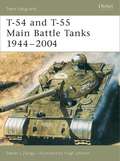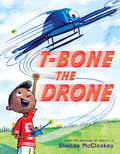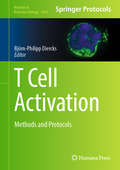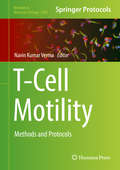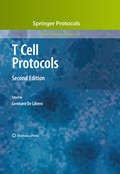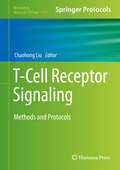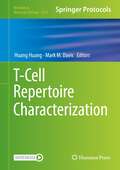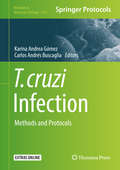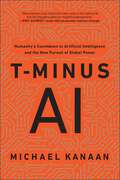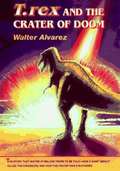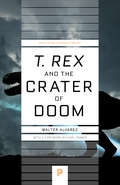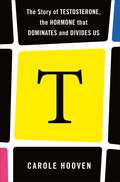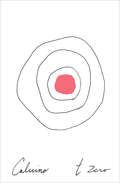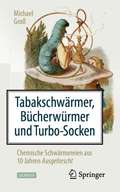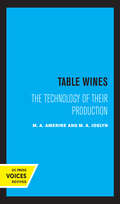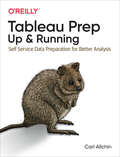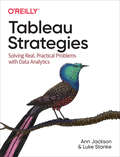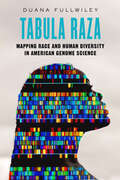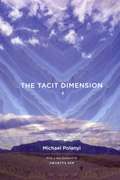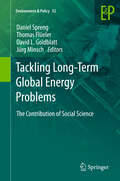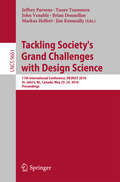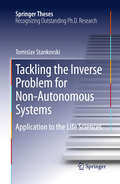- Table View
- List View
T-54 and T-55 Main Battle Tanks, 1944-2004
by Steven J. ZalogaThe T-54 and T-55 tanks are the most widely manufactured tanks of all time. They have become ubiquitous to wars around the globe since the 1950s, starting with Hungary in 1956, and including the the Arab-Israeli wars of 1967, 1973 and 1982, the Vietnam war of 1967-75, the Iran-Iraq War of 1980-88, the Afghanistan conflict, Operation Desert Storm, the Yugoslav Civil Wars, and the recent conflict in Iraq. This book will examine the roots of this prolific tank family, starting with the Soviet Army's first attempts to replace the legendary T-34 during World War II, and covering the T-43 and the T-44, the more successful T-54, and its ultimate evolution into the T-55.
T-Bone the Drone
by Shanda McCloskeyA new tech toy brings epic trials and triumphs in this playtime adventure for fans of The Most Magnificent Thing and Iggy Peck, Architect.Lucas has a new best friend when he bring T-Bone the Drone home from the store. They enjoy playing, flying, and even recharging together--but Lucas has been spending so much time with his new toy that he's on the sidelines when he tries to join the neighborhood Wiffle ball game. When the ball sails over the fence where a scary dog lives, it's the perfect opportunity for Lucas and T-Bone to do what friends do best: work together! It turns out that they'll need help from the whole team, though, to save the day...Finding the solution takes a little ingenuity and a lot of teamwork in this companion story to Doll-E 1.0 celebrating the inventive spirit of modern play.
T Cell Activation: Methods and Protocols (Methods in Molecular Biology #2904)
by Björn-Philipp DiercksThis volume provides detailed, up-to-date methods used in basic and applied research on T-cell activation. Chapters explore the fundamentals in T-cell biology a board range cutting-edge techniques from initial Ca2+ live-cell imaging to downstream effector functions in autoimmune disease. Written in the format of the highly successful Methods in Molecular Biology series, each chapter includes an introduction to the topic, lists necessary materials and reagents, includes tips on troubleshooting and known pitfalls, and step-by-step, readily reproducible protocols. Authoritative and cutting-edge, T- cell activation: Methods and Protocols will be an indispensable protocol collection for researchers studying T-cell activation in inflammation and immunity.
T-Cell Motility: Methods and Protocols (Methods in Molecular Biology #1930)
by Navin Kumar VermaThis volume discusses the latest developments in cellular, molecular, biochemical, and imaging assays to study the biology and functions of T-cells. The chapters in this book cover topics such as LFA-1/ICAM-1 interactions in T-cell motility; using 3D-SIM to dissect signaling cross-talks in motile T-cells; GapmeR-mediated gene silencing in motile T-cells; activity of cellular kinases in migrating T-cells; and computational analysis of protein-protein interactions in motile T-cells. Written in the highly successful Methods in Molecular Biology series format, chapters include introductions to their respective topics, lists of the necessary materials and reagents, step-by-step, readily reproducible laboratory protocols, and tips on troubleshooting and avoiding known pitfalls.Cutting-edge and comprehensive, T-Cell Motility: Methods and Protocols is an essential resource for graduate students, postdoctoral fellows, and principal investigators working in the fields of immunology, T-cell biology, biochemistry, molecular biology, and imaging.
T Cell Protocols
by Gennaro De LiberoWith a wide variety of investigative approaches, T cell immunology is a vital and open field of study. In T Cell Protocols, Second Edition, an international panel of experts contribute fully updated classic protocols as well as newly established novel techniques for the study of T lymphocyte biology. Written in the highly successful Methods in Molecular BiologyTM series format, the chapters in this volume provide brief introductions to the topics, lists of the necessary materials and reagents, step-by-step, readily reproducible laboratory protocols, and Notes sections which collect expert tips on troubleshooting and avoiding known pitfalls. Up-to-date and easy to use, T Cell Protocols, Second Edition is an ideal guide for young investigators new to the complex field of immunology as well as a valuable, concise resource for experienced scientists searching for clear, efficacious descriptions of novel methods.
T-Cell Receptor Signaling: Methods and Protocols (Methods in Molecular Biology #2111)
by Chaohong LiuThis volume provides current and new advanced methods and protocols to study T cells. Chapters guide readers through T cell diversity using mass cytometry, analyzing T cells from single cell level, CRISPR/Cas9 techniques to study the T cell activation, techniques to study subsets of Tcell’s, procedures to study artificial antigen presentosomes for T cell activation, techniques to study the T cell development, two-photon microscopy, and MAIT cells. Written in the highly successful Methods in Molecular Biology series format, chapters include introductions to their respective topics, lists of the necessary materials and reagents, step-by-step, readily reproducible laboratory protocols, and tips on troubleshooting and avoiding known pitfalls. Authoritative and cutting-edge, T-Cell Receptor Signaling: Methods and Protocols aims to provide a wide range of approaches and be an invaluable resource for present and future generations of T cell researchers.
T-Cell Repertoire Characterization (Methods in Molecular Biology #2574)
by Huang Huang Mark M. DavisThis volume provides a comprehensive compilation of protocols in T cell repertoire analysis, from the leading experts in the field, representing both well-established methods and cutting-edge advances. Chapters broadly cover the emerging new T cell subsets, sequencing technologies for capturing TCR repertoire, and computational tools for analyzing an ever-growing TCR repertoire, with a particular focus on how to link the sequence with TCR antigen specificity. Written in the successful Methods in Molecular Biology series format, chapters include introductions to their respective topics, lists of the necessary materials and reagents, step-by-step, readily reproducible protocols, and notes on troubleshooting and avoiding known pitfalls. Authoritative and cutting-edge, T-Cell Repertoire Characterization aims to be a useful practical guide to researches to help further their study in this field.
T. cruzi Infection: Methods and Protocols (Methods in Molecular Biology #1955)
by Karina Andrea Gómez Carlos Andrés BuscagliaThis volume provides detailed descriptions on cutting-edge experimental methods to assess the multiple and complex interactions between T. cruzi and its host. Chapters detail a series of methods and protocols, ranging from rather classical biochemical/genetic approaches to modern, powerful and high-throughput ‘-omics’ technologies, to tackle this issue, as well as novel techniques to improve treatment and clinical evaluation of Chagasic patients. Genome-wide mining strategies aimed at identifying potential parasite antigens and vaccine candidates and an overview on the challenges and milestones encountered during T. cruzi genome assembly are also included. Written in the highly successful Methods in Molecular Biology series format, chapters include introductions to their respective topics, lists of the necessary materials and reagents, step-by-step, readily reproducible laboratory protocols, and tips on troubleshooting and avoiding known pitfalls.Authoritative and cutting-edge, T. cruzi Infection: Methods and Protocols aims to provide students, researchers, and clinicians who are interested in the study of Chagas disease an indispensable source of information.
T-Minus AI: Humanity's Countdown to Artificial Intelligence and the New Pursuit of Global Power
by Michael KanaanLate in 2017, the global significance of the conversation about artificial intelligence (AI) changed forever. China put the world on alert when it released a plan to dominate all aspects of AI across the planet. Only weeks later, Vladimir Putin raised a Russian red flag in response by declaring AI the future for all humankind, and proclaiming that, "Whoever becomes the leader in this sphere will become the ruler of the world." The race was on. Consistent with their unique national agendas, countries throughout the world began plotting their paths and hurrying their pace. Now, not long after, the race has become a sprint. Despite everything at stake, to most of us AI remains shrouded by a cloud of mystery and misunderstanding. Hidden behind complicated and technical jargon and confused by fantastical depictions of science fiction, the modern realities of AI and its profound implications are hard to decipher, but crucial to recognize. In T-Minus AI: Humanity's Countdown to Artificial Intelligence and the New Pursuit of Global Power, author Michael Kanaan explains AI from a human-oriented perspective we can all finally understand. A recognized national expert and the U.S. Air Force's first Chairperson for Artificial Intelligence, Kanaan weaves a compelling new view on our history of innovation and technology to masterfully explain what each of us should know about modern computing, AI, and machine learning. Kanaan also dives into the global implications of AI by illuminating the cultural and national vulnerabilities already exposed and the pressing issues now squarely on the table. AI has already become China's all-purpose tool to impose its authoritarian influence around the world. Russia, playing catch up, is weaponizing AI through its military systems and now infamous, aggressive efforts to disrupt democracy by whatever disinformation means possible. America and like-minded nations are awakening to these new realities—and the paths they're electing to follow echo loudly the political foundations and, in most cases, the moral imperatives upon which they were formed. As we march toward a future far different than ever imagined, T-Minus AI is fascinating and crucially well-timed. It leaves the fiction behind, paints the alarming implications of AI for what they actually are, and calls for unified action to protect fundamental human rights and dignities for all.
T Regulatory Cells in Human Health and Diseases (Advances in Experimental Medicine and Biology #1278)
by Song-Guo ZhengThis book addresses one of the major challenges of immunology today that is being directed to the translation of the rapidly emerging volume of basic science contributions of immunology to clinical medicine. In so doing, the book systemically introduces and discusses concepts, classifications, phenotypic and functional descriptions of regulatory T (Treg) cells in health and disease. The authors of the 15 chapters were selected from among the most qualified experts in the field of Treg cell research who provide a comprehensive overview of Treg cells and their biology in the ensuing chapters.The beginning chapters provide a useful contemporary classification of Treg cell populations and then progress to chapters that explore basic mechanisms of Treg cell function and epigenetic control. In addition to descriptions of typical CD4+ Foxp3+ cells, other chapters provide detailed presentations of Treg subsets such as CD8+ Tregs and IL-10-producing Tr1 cells. The differences of various Treg subsets, as well as circulating and resident Treg cell populations, are next compared. Importantly, the next chapters provide the clinical correlation of Treg cells with autoimmune diseases, inflammatory diseases, metabolic diseases, cancer and organ transplantation and progress to chapters that highlight emerging innovative technology including nanoparticle-Treg cells and their translational values. In summary, the book will provide a valuable resource not only for graduate students and researchers in the fields of immunology, cell biology and translational medicine but also for all others interested in learning more about Treg cells and their application in human health and disease.
T. Rex and the Crater of Doom
by Walter AlvarezA geologist describes his research into the extinction of Tyrannosaurus rex and all dinosaurs, caused by a comet or asteroid hitting the Earth.
"T. rex" and the Crater of Doom
by Walter Alvarez Carl ZimmerSixty-five million years ago, a comet or asteroid larger than Mount Everest slammed into the Earth, inducing an explosion equivalent to the detonation of a hundred million hydrogen bombs. Vaporized detritus blasted through the atmosphere upon impact, falling back to Earth around the globe. Disastrous environmental consequences ensued: a giant tsunami, continent-scale wildfires, darkness, and cold, followed by sweltering greenhouse heat. When conditions returned to normal, half the plant and animal genera on Earth had perished.This horrific chain of events is now widely accepted as the solution to a great scientific mystery: what caused the extinction of the dinosaurs? Walter Alvarez, one of the Berkeley scientists who discovered evidence of the impact, tells the story behind the development of the initially controversial theory. It is a saga of high adventure in remote locations, of arduous data collection and intellectual struggle, of long periods of frustration ended by sudden breakthroughs, of friendships made and lost, and of the exhilaration of discovery that forever altered our understanding of Earth's geological history.
"T. rex" and the Crater of Doom
by Walter Alvarez Carl ZimmerSixty-five million years ago, a comet or asteroid larger than Mt. Everest slammed into the Earth, causing an explosion equivalent to the detonation of a hundred million hydrogen bombs. Vaporized impactor and debris from the impact site were blasted out through the atmosphere, falling back to Earth all around the globe. Terrible environmental disasters ensued, including a giant tsunami, continent-scale wildfires, darkness, and cold, followed by sweltering greenhouse heat. When conditions returned to normal, half the genera of plants and animals on Earth had perished.This horrific story is now widely accepted as the solution to a great scientific murder mystery what caused the extinction of the dinosaurs? In T. rex and the Crater of Doom, the story of the scientific detective work that went into solving the mystery is told by geologist Walter Alvarez, one of the four Berkeley scientists who discovered the first evidence for the giant impact. It is a saga of high adventure in remote parts of the world, of patient data collection, of lonely intellectual struggle, of long periods of frustration ended by sudden breakthroughs, of intense public debate, of friendships made or lost, of the exhilaration of discovery, and of delight as a fascinating story unfolded.Controversial and widely attacked during the 1980s, the impact theory received confirmation from the discovery of the giant impact crater it predicted, buried deep beneath younger strata at the north coast of the Yucatán Peninsula. The Chicxulub Crater was found by Mexican geologists in 1950 but remained almost unknown to scientists elsewhere until 1991, when it was recognized as the largest impact crater on this planet, dating precisely from the time of the great extinction sixty-five million years ago. Geology and paleontology, sciences that long held that all changes in Earth history have been calm and gradual, have now been forced to recognize the critical role played by rare but devastating catastrophes like the impact that killed the dinosaurs.
"T. rex" and the Crater of Doom
by Carl Zimmer Walter AlvarezSixty-five million years ago, a comet or asteroid larger than Mount Everest slammed into the Earth, inducing an explosion equivalent to the detonation of a hundred million hydrogen bombs. Vaporized detritus blasted through the atmosphere upon impact, falling back to Earth around the globe. Disastrous environmental consequences ensued: a giant tsunami, continent-scale wildfires, darkness, and cold, followed by sweltering greenhouse heat. When conditions returned to normal, half the plant and animal genera on Earth had perished.This horrific chain of events is now widely accepted as the solution to a great scientific mystery: what caused the extinction of the dinosaurs? Walter Alvarez, one of the Berkeley scientists who discovered evidence of the impact, tells the story behind the development of the initially controversial theory. It is a saga of high adventure in remote locations, of arduous data collection and intellectual struggle, of long periods of frustration ended by sudden breakthroughs, of friendships made and lost, and of the exhilaration of discovery that forever altered our understanding of Earth's geological history.
T: The Story of Testosterone, the Hormone that Dominates and Divides Us
by Carole HoovenThrough riveting personal stories and the latest research, Harvard evolutionary biologist Carole Hooven shows how testosterone drives the behavior of the sexes apart and how understanding the science behind this hormone is empowering for all.Since antiquity—from the eunuchs in the royal courts of ancient China to the booming market for “elixirs of youth” in nineteenth-century Europe—humans have understood that typically masculine behavior depends on testicles, the main source of testosterone in males. Which sex has the highest rates of physical violence, hunger for status, and desire for a high number of sex partners? Just follow the testosterone.Although we humans can study and reflect on our own behavior, we are also animals, the products of millions of years of evolution. Fascinating research on creatures from chimpanzees to spiny lizards shows how high testosterone helps males out-reproduce their competitors. And men are no exception.While most people agree that sex differences in human behavior exist, they disagree about the reasons. But the science is clear: testosterone is a potent force in human society, driving the bodies and behavior of the sexes apart. But, as Hooven shows in T, it does so in concert with genes and culture to produce a vast variety of male and female behavior. And, crucially, the fact that many sex differences are grounded in biology provides no support for restrictive gender norms or patriarchal values. In understanding testosterone, we better understand ourselves and one another—and how we might build a fairer, safer society.
t zero
by Italo CalvinoA collection of stories about time, space, and the evolution of the universe in which the author blends mathematics with poetic imagination. "Calvino does what very few writers can do: he describes imaginary worlds with the most extraordinary precision and beauty" (Gore Vidal, New York Review of Books). Translated by William Weaver. A Helen and Kurt Wolff Book
Tabakschwärmer, Bücherwürmer und Turbo-Socken: Chemische Schwärmereien aus 10 Jahren Ausgeforscht
by Michael GroßDieses Buch präsentiert 70 Merkwürdigkeiten der „Ausgeforscht“-Glossen der Nachrichten aus der Chemie von Michael Groß. Obskure Aspekte und Meldungen aus der Wissenschaft werden aufgespießt und die Lesenden damit sowohl zum Schmunzeln als auch zum Nachdenken angeregt. Eingehend analysiert, in Kakao inkubiert und in Heiterkeit aufgelöst wird dabei auch die Wechselwirkung zwischen Wissenschaft und Technologie, dem menschlichen Alltagsleben und Konsumverhalten: von stinkenden Socken bis hin zu den perlenden Gasblasen des Champagner.Der wissenschaftliche Hintergrund der Glossen erstreckt sich von der Biologie über die Chemie bis hin zur Quantenmechanik - der alltäglich-kuriose Vordergrund von neumodischen, völlig überflüssigen Erfindungen bis hin zu traditionellen Grundnahrungsmitteln wie Bier und Wein.Der Autor Michael Groß studierte Chemie und erforschte am Oxford Centre for Molecular Sciences die biophysikalische Chemie der Proteine. Heute lebt er als freier Wissenschaftsjournalist in Oxford und schreibt regelmäßig Sachbücher und Beiträge u.a. für Spektrum der Wissenschaft, Chemie in unserer Zeit und Nachrichten aus der Chemie. 2014 wurde er von der Gesellschaft Deutscher Chemiker mit dem GDCh-Preis für Journalisten und Schriftsteller ausgezeichnet.
Table Wines: The Technology of Their Production
by M. A. Amerine M.A. JoslynThis title is part of UC Press's Voices Revived program, which commemorates University of California Press’s mission to seek out and cultivate the brightest minds and give them voice, reach, and impact. Drawing on a backlist dating to 1893, Voices Revived makes high-quality, peer-reviewed scholarship accessible once again using print-on-demand technology. This title was originally published in 1970.
Tableau Prep: Self-service Data Preparation For Better Analysis
by Carl AllchinFor self-service data preparation, Tableau Prep is relatively easy to use—as long as you know how to clean and organize your datasets. Carl Allchin, from The Information Lab in London, gets you up to speed on Tableau Prep through a series of practical lessons that include methods for preparing, cleaning, automating, organizing, and outputting your datasets.Based on Allchin’s popular blog, Preppin’ Data, this practical guide takes you step-by-step through Tableau Prep’s fundamentals. Self-service data preparation reduces the time it takes to complete data projects and improves the quality of your analyses. Discover how Tableau Prep helps you access your data and turn it into valuable information.Know what to look for when you prepare dataLearn which Tableau Prep functions to use when working with data fieldsAnalyze the shape and profile of your datasetOutput data for analysis and learn how Tableau Prep automates your workflowLearn how to clean your dataset using Tableau Prep functionsExplore ways to use Tableau Prep techniques in real-world scenariosMake your data available to others by managing and documenting the output
Tableau Strategies: Solving Real, Practical Problems with Data Analytics
by Ann Jackson Luke StankeIf you want to increase Tableau's value to your organization, this practical book has your back. Authors Ann Jackson and Luke Stanke guide data analysts through strategies for solving real-world analytics problems using Tableau. Starting with the basics and building toward advanced topics such as multidimensional analysis and user experience, you'll explore pragmatic and creative examples that you can apply to your own data.Staying competitive today requires the ability to quickly analyze and visualize data and make data-driven decisions. With this guide, data practitioners and leaders alike will learn strategies for building compelling and purposeful visualizations, dashboards, and data products. Every chapter contains the why behind the solution and the technical knowledge you need to make it work.Use this book as a high-value on-the-job reference guide to TableauVisualize different data types and tackle specific data challengesCreate compelling data visualizations, dashboards, and data productsLearn how to generate industry-specific analyticsExplore categorical and quantitative analysis and comparisonsUnderstand geospatial, dynamic, statistical, and multivariate analysisCommunicate the value of the Tableau platform to your team and to stakeholders
Tabula Raza: Mapping Race and Human Diversity in American Genome Science (Atelier: Ethnographic Inquiry in the Twenty-First Century #14)
by Duana FullwileyDuana Fullwiley has penned an intimate chronicle of laboratory life in the genomic age. She presents many of the influential scientists at the forefront of genetics who have redefined how we practice medicine and law and understand ancestry in an era of big data and waning privacy. Exceedingly relatable and human, the scientists in these pages often struggle for visibility, teeter on the tightrope of inclusion, and work tirelessly to imprint the future. As they actively imagine a more equal and just world, they often find themselves ensnared in reproducing timeworn conceits of race and racism that can seed the same health disparities they hope to resolve. Nothing dynamic can live for long as a blank slate, an innocent tabula rasa. But how the blank slate of the once-raceless human genome became one of racial differences, in various forms of what Fullwiley calls the tabula raza, has a very specific and familiar history—one that has cycled through the ages in unexpected ways.
The Tacit Dimension
by Michael Polanyi"I shall reconsider human knowledge by starting from the fact that we can know more than we can tell," writes Michael Polanyi, whose work paved the way for the likes of Thomas Kuhn and Karl Popper. The Tacit Dimension argues that tacit knowledge-- tradition, inherited practices, implied values, and prejudgments-- is a crucial part of scientific knowledge. Back in print for a new generation of students and scholars, this volume challenges the assumption that skepticism, rather than established belief, lies at the heart of scientific discovery. "Polanyi's work deserves serious attention... [This is a] compact presentation of some of the essentials of his thought. "--Review of Metaphysics "Polanyi's work is still relevant today and a closer examination of this theory that all knowledge has personal and tacit elements... can be used to support and refute a variety of widely held approaches to knowledge management. "--Electronic Journal of Knowledge "The reissuing of this remarkable book give us a new opportunity to see how far-reaching-- and foundational-- Michael Polanyi's ideas are, on some of the age-old questions in philosophy. "--Amartya Sen, from the new Foreword
Tackling Long-Term Global Energy Problems: The Contribution of Social Science
by Daniel Spreng Thomas Flüeler David L. Goldblatt Jürg MinschThis book makes a case for a multidisciplinary and transdisciplinary approach to energy research--one that brings more of the social sciences to bear. Featuring eight studies from across the spectrum of the social sciences, each applying multiple disciplines to one or more energy-related problems, the book demonstrates the strong analytical and policy-making potential of such a broadened perspective. Case studies include: energy transitions of households in developing countries, the 'curse of oil', politics and visions for renewables, economics and ethics in emissions trading, and carbon capture and storage.
Tackling Society's Grand Challenges with Design Science
by Jeffrey Parsons Tuure Tuunanen John Venable Brian Donnellan Markus Helfert Jim KenneallyThis book constitutes the thoroughly refereed proceedings of the 11th International Conference on Design Science Research in Information Systems and Technology, DESRIST 2016, held in St. John, Newfoundland, Canada, in May 2016. The 11 full papers, 2 short papers and 9 short papers describing prototypes and products were carefully reviewed and selected from 54 submissions. The papers are organized around the following topics: methodological aspects of design science; applications of design science research to real world design problems, for example in social media, health care systems, embedded technologies, climate, security.
Tackling the Inverse Problem for Non-Autonomous Systems: Application to the Life Sciences
by Tomislav StankovskiThis thesis presents a new method for following evolving interactions between coupled oscillatory systems of the kind that abound in nature. Examples range from the subcellular level, to ecosystems, through climate dynamics, to the movements of planets and stars. Such systems mutually interact, adjusting their internal clocks, and may correspondingly move between synchronized and non-synchronized states. The thesis describes a way of using Bayesian inference to exploit the presence of random fluctuations, thus analyzing these processes in unprecedented detail. It first develops the basic theory of interacting oscillators whose frequencies are non-constant, and then applies it to the human heart and lungs as an example. Their coupling function can be used to follow with great precision the transitions into and out of synchronization. The method described has the potential to illuminate the ageing process as well as to improve diagnostics in cardiology, anesthesiology and neuroscience, and yields insights into a wide diversity of natural processes.
